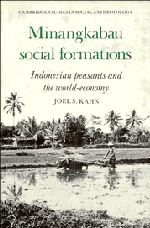Book contents
- Frontmatter
- Contents
- Lists of maps, figures and tables
- Preface
- Map
- 1 Introduction
- 2 The internal and the external in a Minangkabau village: an introduction to the world of the concrete
- 3 Adat, kinship and marriage: the constitution of the subsistence community
- 4 Agriculture and subsistence: the reproduction of the subsistence community
- 5 Commodity production in the village economy: the case of blacksmithing
- 6 Occupation, class and the peasant economy
- 7 The structure of petty commodity production
- 8 Mercantilism and the evolution of ‘traditional’ society
- 9 The emergence of petty commodity production
- 10 Conclusions: The concept of a neo-colonial social formation
- Bibliography
- Glossary of Minangkabau terms
- Index
- CAMBRIDGE STUDIES IN SOCIAL ANTHROPOLOGY
7 - The structure of petty commodity production
Published online by Cambridge University Press: 29 September 2009
- Frontmatter
- Contents
- Lists of maps, figures and tables
- Preface
- Map
- 1 Introduction
- 2 The internal and the external in a Minangkabau village: an introduction to the world of the concrete
- 3 Adat, kinship and marriage: the constitution of the subsistence community
- 4 Agriculture and subsistence: the reproduction of the subsistence community
- 5 Commodity production in the village economy: the case of blacksmithing
- 6 Occupation, class and the peasant economy
- 7 The structure of petty commodity production
- 8 Mercantilism and the evolution of ‘traditional’ society
- 9 The emergence of petty commodity production
- 10 Conclusions: The concept of a neo-colonial social formation
- Bibliography
- Glossary of Minangkabau terms
- Index
- CAMBRIDGE STUDIES IN SOCIAL ANTHROPOLOGY
Summary
In the previous six chapters I have presented material on the peasant economy of Minangkabau, as well as attempting to place the peasant economy in its social and economic setting in the modern Minangkabau village. I have been concerned to show that an understanding of peasant economy rests on an understanding of the operation of small-scale commodity production and distribution. I have taken some care to keep this description in historical context, assuming both that this form of economy is particular and that it is historically specific. As we shall see in later chapters, Minangkabau economic organisation in the past has been quite different. In other words, this form of peasant economy has a prehistory as well as a history, to use Marx's term. This being the case it becomes necessary, in order to understand the economic conditions in modern Minangkabau to understand both its own laws of operation and the historical conditions under which such an economic system was born in the specific history of the Indonesian social formation.
There are, therefore, two major questions which need to be answered. First, the (in a sense) more anthropological question – given what I have called petty commodity production, what are its implications? Secondly, how was the petty commodity economy formed – what are its conditions of existence, reproduction and future transformation? Only in this way can we claim to have located the peasant economy in space and time.
- Type
- Chapter
- Information
- Minangkabau Social FormationsIndonesian Peasants and the World-Economy, pp. 130 - 150Publisher: Cambridge University PressPrint publication year: 1980



